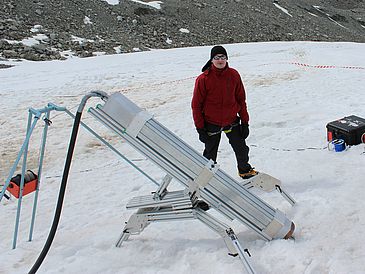Throughout history, humans have speculated whether life exists elsewhere in the universe. The watery oceans lying under the thick ice crusts on some of the moons in our solar system may well be able to provide clues to the answer. To find out, scientists must first get hold of some pure untouched water samples. The small Saturn moon Enceladus is very promising in this respect: it is spitting water into space out of cracks in its South Pole. Initial surveys carried out by NASA have detected simple organic compounds. Landing on Enceladus to collect water samples, though, presents an enormous technical challenge. The University of Bremen’s Cognitive Neuroinformatics Institute has been working on the development of an important key component for such a future expedition into space.
The project “Enceladus Explorer” (EnEx) is creating one of the prerequisites for such a future space mission. Supported by the Deutsches Zentrum für Luft- und Raumfahrt (DLR) [German Aeronautics and Space Research Center], engineers and scientists from six German universities have joined together to form a Collaborative Research Group. The initial task was to develop the key technologies requisite for extracting an uncontaminated water sample from Enceladus, i.e. a sample free from any micro-organisms brought from Earth. In addition the project team was to investigate possible mission scenarios, and carry out an Earth-bound test of the newly developed technologies. The field test was implemented in cooperation with American researchers from the National Science Foundation (NSF) who are running a parallel project with the title “Minimally Invasive Direct Glacial Exploration” (MIDGE). The aim of the joint MIDGE/EnEx project was for the first time to extract an uncontaminated sub-glacial (i.e. from under the ice) water sample from a location called Blood Falls in Antarctica.
An indispensible piece of equipment for such a mission is an melting probe that can be remotely navigated through the ice. It must be capable of “seeing” in front of it and determining its precise location in the ice. The technology for this was developed over the past three years in a joint effort involving engineers and scientists at the FH Aachen, the RWTH Aachen, the TU Braunschweig, the University of Bremen, the Universität der Bundeswehr München, and the University of Wuppertal. The results then had to be integrated into an melting probe called EnEx-IceMole which was developed by researchers in the Faculty of Aeronautics and Space Technology at the FH Aachen.
A short while ago at Blood Falls, the MIDGE/EnEx team managed for the very first time to minimally-invasively extract an uncontaminated sub-glacial water sample from an ice-depth of 16 meters. The American colleagues are now analyzing the water sample, which may have been isolated from the outside world for as long as a million years. It also contains micro-organisms that have adapted to the extreme conditions. Before being allowed to take the sample, the researchers had to overcome a serious administrative hurdle: the field-test area is classified as an “Antarctic Specially Protected Area”. The researchers therefore had to observe very strict regulations, and the ice-melting probe had to be repeatedly stepwise sterilized. This would of course also be necessary before being used in outer space to ensure that the ice moon is not contaminated with earthly micro-organisms. With their successful field-test the EnEx Collaborative Research Group has shown that the newly developed technologies work in principle and may potentially also be used on Enceladus.
The University of Bremen developed the navigation software for the probe
The University of Bremen is involved in the project via its Cognitive Neuroinformatics research group. Led by Professor Kerstin Schill, Bremen researchers developed the techniques for calculating the location of the probe when it is in the ice and for mapping the surroundings. One of the challenges that have to be overcome when navigating in ice is that it is not possible to use technologies that are quite commonplace above ground, such as satellite navigation or visual positioning techniques. On top of this, it is impossible to know beforehand whether there any obstacles concealed in the probe’s path. The probe therefore has to be steered exclusively by means of on-board sensors, used together with an external system of acoustic positioning. All the data from these sensors is fed into the software developed at the University of Bremen, which is then able to calculate the exact position of the probe down to an accuracy of just a few centimeters. Simultaneously, and based on identifying structures in the ice like stones, air pockets and cracks, a three-dimensional map is produced of the immediate surroundings. The navigation data is then processed and graphically displayed so the operator of the probe is able to steer it safely through the ice.
Following the project’s successful completion the research work will continue within the context of the German Aeronautics and Space Research Center’s “EnEx – Enceladus Explorer” initiative. The focus will shift to developing the tested techniques into an autonomously acting system capable of navigating the probe independently through the ice – an important prerequisite for future space missions.
If you would like to have more information on this topic, please contact:
University of Bremen
Faculty of Mathematics / Computer Sciences
Institute Cognitive Neuroinformatics
Joachim Clemens
Phone: +49 421 218 64218
e-mail: jayceeprotect me ?!informatik.uni-bremenprotect me ?!.de
http://www.informatik.uni-bremen.de/cog_neuroinf

